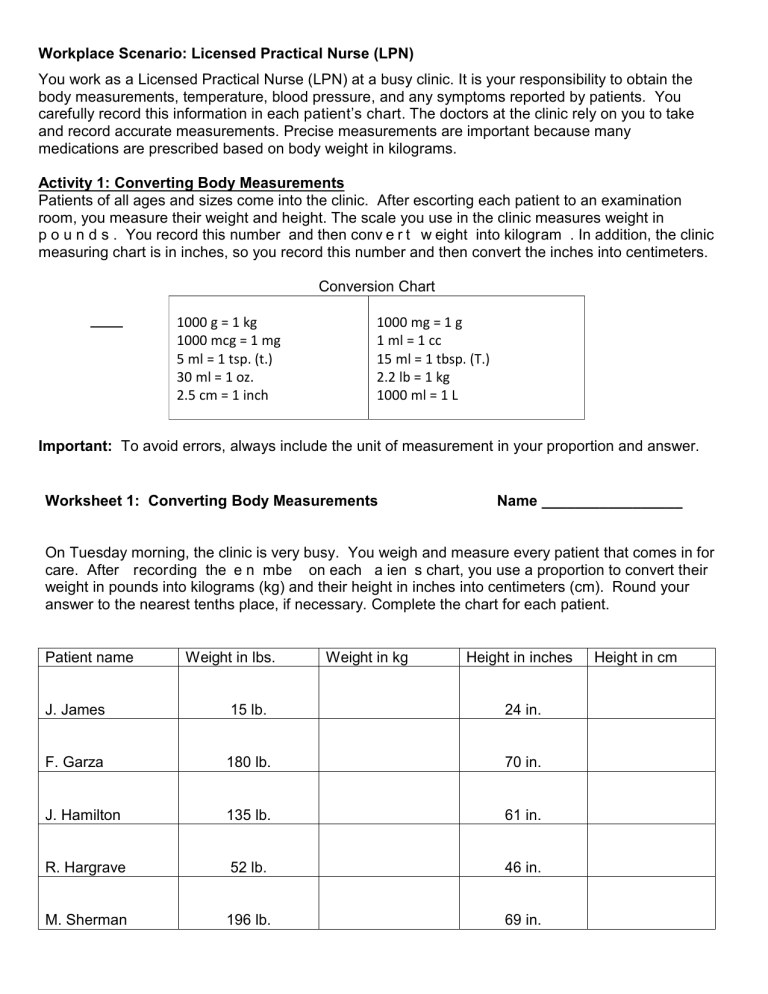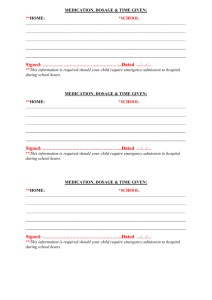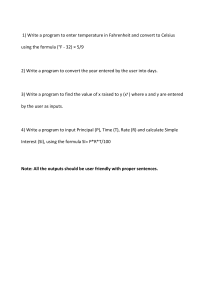
Workplace Scenario: Licensed Practical Nurse (LPN) You work as a Licensed Practical Nurse (LPN) at a busy clinic. It is your responsibility to obtain the body measurements, temperature, blood pressure, and any symptoms reported by patients. You carefully record this information in each patient’s chart. The doctors at the clinic rely on you to take and record accurate measurements. Precise measurements are important because many medications are prescribed based on body weight in kilograms. Activity 1: Converting Body Measurements Patients of all ages and sizes come into the clinic. After escorting each patient to an examination room, you measure their weight and height. The scale you use in the clinic measures weight in p o u n d s . You record this number and then conv e r t w eight into kilogram . In addition, the clinic measuring chart is in inches, so you record this number and then convert the inches into centimeters. Conversion Chart 1000 g = 1 kg 1000 mcg = 1 mg 5 ml = 1 tsp. (t.) 30 ml = 1 oz. 2.5 cm = 1 inch 1000 mg = 1 g 1 ml = 1 cc 15 ml = 1 tbsp. (T.) 2.2 lb = 1 kg 1000 ml = 1 L Important: To avoid errors, always include the unit of measurement in your proportion and answer. Worksheet 1: Converting Body Measurements Name _________________ On Tuesday morning, the clinic is very busy. You weigh and measure every patient that comes in for care. After recording the e n mbe on each a ien s chart, you use a proportion to convert their weight in pounds into kilograms (kg) and their height in inches into centimeters (cm). Round your answer to the nearest tenths place, if necessary. Complete the chart for each patient. Patient name Weight in lbs. Weight in kg Height in inches J. James 15 lb. 24 in. F. Garza 180 lb. 70 in. J. Hamilton 135 lb. 61 in. R. Hargrave 52 lb. 46 in. M. Sherman 196 lb. 69 in. Height in cm D. Hagopian 238 lb. 73 in. L. Wolf 78 lb. 55 in. V. Graham 162 lb. 60 in. D. Mendez 140 lb. 67 in. R. Smith 38 lb. 39 in. M. Abdul 172 lb. 57 in. P. Baker 128 lb. 65 in. 4 Activity 2: Converting Fahrenheit and Celsius Temperature In addition to measuring weight and height, you also take and record each p a t i e n t t e m p e r a t u r e . You usually use a Fahrenheit thermometer, but the clinic recently purchased a Celsius thermometer. While the doctors prefer the Celsius reading, most patients are more familiar with the Fahrenheit temperature reading. Regardless of which thermometer you use, the doctors at the clinic have instructed you to record both readings in the patients chart. Since you have worked at the clinic for a few years, you know the following temperatures have important medical significance. Use the appropriate conversion formula and convert each Fahrenheit temperature to Celsius. Mild Hypothermia: 950 F = _______________0C Moderate to severe hypothermia: 900 F = ________________0C Mild Fever: 1000 F = __________________0C Moderate Fever: 1020 F = _________________0C Severe Fever: 1040 F = __________________0C Worksheet 2: Converting Temperature Readings Name ___________________ You took the temperature of each patient who came into the clinic on Tuesday morning. Depending on which the thermometer you use d, some temperatures were taken in Fahrenheit degrees, and others in Celsius degrees. For each given temperature reading on the chart, use the appropriate formula to convert to the other system. Round your answer to the nearest tenths place, if necessary. Patient name J. James Fahrenheit temperature reading Celsius temperature reading 1010 F 370 C F. Garza J. Hamilton 98.80 F R. Hargrave 98.60 F M. Sherman 99.30 F 38.50 C D. Hagopian 390 C L. Wolf V. Graham 990 F 37.30 C D. Mendez R. Smith 101.50 F M. Abdul 98.50 F 36.70 C P. Baker After completing the chart, answer the following questions. 1. According to your calculations, how many patients have a fever? 2. Which patient has the highest temperature? 3. What is the temperature in Celsius for this patient? 4. What is the medically significant classification of this temperature? 6 Quiz: Measurement Conversions & Dosage per Body Weight Name: __________________ Convert each of the following weights into kilograms (kg) and heights into centimeters (cm) 1. 55 lb. = __________kg 6. 45 inches = _____________cm 2. 100 lb. = _________kg 7. 58 inches = _____________cm 3. 155 lb. = _________kg 8. 66 inches = _____________cm 4. 270 lb. = _________kg 9. 75 inches = _____________cm 5. 22 lb. = __________kg 10. 28 inches = _____________cm Convert each of the temperatures to Fahrenheit or Celsius as indicated. 11. An infant has a body temperature of 96.50F 12. Store the vaccine serum at 80C __________ 0C __________ 0F 13. Do not expose the medication to temperatures greater than 750F 14. M . Doe em e a Con e each a ien __________0C e i g ea e han 1030F __________ 0C eigh o kilog am (kg) and calculate the medication dosage 15. Dr. Patel orders 40 mg/kg of medication for a patient weighing 150 lb. Patient weighs _________ kg Dosage: ___________mg 16. A patient weighing 300 lb. is prescribed medication of 25 mg/kg of body weight. Patient weighs __________kg Dosage: ___________mg 17. Dr. Jones orders 5mg/kg of medication for a patient weighing 75 lb. Patient weighs __________kg Dosage: ___________mg 18. A doctor orders 2500 mg of medication for a patient weighing 125 lb. The recommended dosage for this drug is 30-40 mg/kg. Determine if the dosage is safe for this patient. Patient weighs __________kg Dosage range: Minimum________ to _________Maximum Is the dosage ordered safe for this patient? Yes 9 or No Worksheet 1: Converting Body Measurements Answer Key On Tuesday morning, the clinic is very busy. You weight and measure every patient that comes in for ca e. Af e eco ding he e n mbe on each a ien cha , o e a o o ion o con e hei weight in pounds into kilograms (kg) and their height in inches into centimeters (cm). Round your answer to the nearest tenths place, if necessary. Patient name Weight in lbs. Weight in kg J. James 15 lb. 6.8 kg 24 in. 60 cm F. Garza 180 lb. 81.8 kg 70 in. 175 cm J. Hamilton 135 lb. 61.4 kg 61 in. 152.5 cm R. Hargrave 52 lb. 23.6 kg 46 in. 115 cm M. Sherman 196 lb. 89.1 kg 69 in. 172.5 cm D. Hagopian 238 lb. 108.2 kg 73 in. 182.5 cm L. Wolf 78 lb. 35.5 kg 55 in. 137.5 cm V. Graham 162 lb. 73.6 kg 60 in. 150 cm D. Mendez 140 lb. 63.6 kg 67 in. 167.5 cm R. Smith 38 lb. 17.3 kg 39 in. 97.5 cm M. Abdul 172 lb. 78.2 kg 57 in. 142.5 cm P. Baker 128 lb. 58.2 kg 65 in. 162.5 cm 10 Height in inches Height in cm Worksheet 2: Converting Temperature Readings Answer Key You took the temperature of each patient who came into the clinic on Tuesday morning. Depending on hich he mome e o ed, ome of he a ien em e a e e e aken in Fah enhei degrees, and others in Celsius degrees. For each given temperature reading, use the appropriate formula to convert to the other system. Round your answer to the nearest tenths place, if necessary. Patient name Fahrenheit temperature reading Celsius temperature reading J. James 1010 F 38.30 C F. Garza 98.60 F 370 C J. Hamilton 98.80 F 37.10 C R. Hargrave 98.60 F 370 F M. Sherman 99.30 F 37.40 F D. Hagopian 101.30 F 38.50 C L. Wolf 102.20 F 390 C V. Graham 990 F 37.20 C D. Mendez 99.10 F 37.30 C R. Smith 101.50 F 38.60 C M. Abdul 98.50 F 36.90 C P. Baker 98.10 F 36.70 C After completing the chart, answer the following questions. 1. According to your calculations, how many patients have a fever? 4 2. Which patient has the highest temperature? L. Wolf 3. What is the temperature in Celsius for this patient? 390 C 4. What is the medically significant classification of this temperature? Moderate fever 11 Worksheet 3: Calculating dosage based on patient weight Answer Key Tuesday is a busy day at the clinic. Several patients need medications or shots. You will have to calculate the dosage of medicine based on body weight for some of these patients. Round your answers to the nearest tenths place, if necessary. M. Garcia is to be given medication with a recommended dose of 4 mg/kg of body weight. She weighs 64 kg. How much medicine will you give Ms. Garcia? 256 mg J. Smith weighs 205 lb. The doctor orders 15 mg/kg of medication. Con e he a ien eigh in o kilograms. Mr. Smith weighs 93.2 kg. What is the correct dose of medication for Mr. Smith? 1398 mg. The doctor orders a shot of 0.1 cc/kg medication for a 40 lb. child. Con e he child eigh in o kilog ams. The child weighs 18.2 kg. The correct dose for hi child ho i 1.8 cc. The doctor orders 1500 mg of medication for D. Cameron who weighs185 lb. The label on the medication states the recommended dosage for the medication is 15-25 mg/kg of body weight. Is the dose prescribed by the doctor safe for this patient? Con e he a ien eigh in o kilog am . The patient weighs 84.1 kg. Calculate the dosage range: Minimum dose 1261.5 kg to 2102.5 kg Maximum dose Is the dose prescribed safe for this patient? Yes The doctor prescribed 50 mg/kg divided into 3 equal doses for a toddler who weighs 25 lb. The toddler weighs 11.4 kg. The total dosage to be given is 570 mg. Each individual dose will be 190 mg. 12 Quiz: Measurement Conversions & Dosage per Body Weight Answer Key Convert each of the following weights into kilograms (kg) and heights into centimeters (cm) 1. 55 lb = 6. 45 inches = 112.5 cm 2. 100 lb = __45.5 kg_ 7. 58 inches = 145 cm 3. 155 lb = __70.5 kg_ 8. 66 inches = 165 cm 4. 270 lb = __122.7 kg_ 9. 75 inches = 187.5 cm 5. 22 lb = __25 kg_ __ 10 kg_ 10. 28 inches = 70 cm Convert each of the temperatures to Fahrenheit or Celsius as indicated. 11. An infant has a body temperature of 96.50F 12. Store the vaccine serum at 80C 35.80C 46.40F 13. Do not expose the medication to temperatures greater than 750F 14. M . Doe em e a Convert each a ien e i g ea e han 1030F 23.90C 39.4 0C eigh o kilog am (kg) and calc la e he medica ion do age a di ec ed. 15. Dr. Patel orders 40 mg/kg of medication for a patient weighing 150 lb. Patient weighs _68.2 kg_ Dosage: _2728 mg_ 16. A patient weighing 300 lb. is prescribed medication of 25 mg/kg of body weight. Patient weighs _136.4 kg_ Dosage: _3410 mg_ 17. Dr. Jones orders 5mg/kg of medication for a patient weighing 75 lb. Patient weighs _34.1 kg_ Dosage: _170.5 mg_ 18. A doctor orders 2500 mg of medication for a patient weighing 125 lb. The recommended dosage for this drug is 30-40 mg/kg. Determine if the dosage is safe for this patient. Patient weighs _56.8 kg_ Dosage range: Minimum _1704 mg_ to _2272 mg_ Maximum Is the dosage ordered safe for this patient? No (2500 mg exceeds the maximum dose allowed) 13




